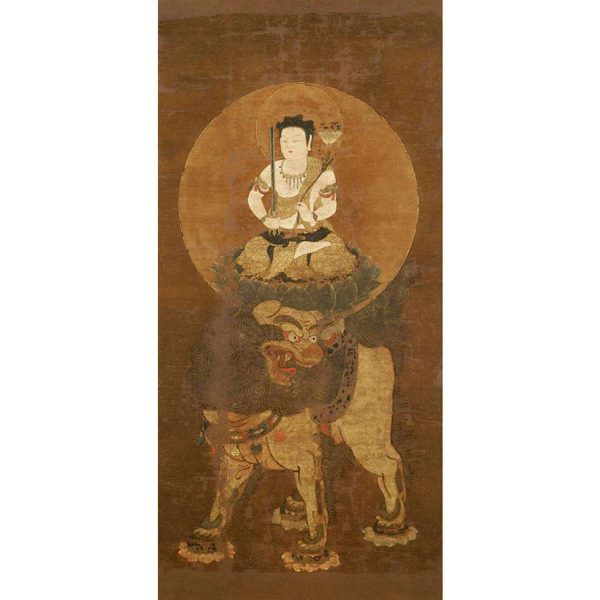불교 미술 | 헤이안~무로마치시대
-

오계문수보살
가마쿠라시대 14세기 마쓰나가 야스자에몬 기증본관 3실
2022년 11월 22일(화) ~ 2022년 12월 25일(일)이 전시실에서는 8세기 말부터 16세기 말에 걸친 일본의 불교 문화 관련 작품을 전시합니다. 불교 문화는 나라시대(710~794)에 들어 천황을 중심으로 하는 국가의 주도하에 전국으로 퍼져 나갔습니다. 헤이안시대(794~1192)에 이르러서는 개인적인 신앙이 궁정 귀족들 사이에도 유행하였고, 풍부한 재력으로 뒷받침된 고도의 기술과 높은 미의식에 의해 섬세하고 우아한 조형이 탄생하였습니다. 이에 따라 점차 일본적인 미의식이 형성되었습니다. 나아가 무사 정권이 성립되는 가마쿠라시대(1192~1333)에는 현실성과 명료함, 약동감이 있는 조형이 사랑받게 되었습니다. 이처럼 오랜 기간에 걸친 일본 불교 문화의 큰 변화 속에서 불교와 관련된 그림, 서예, 조각, 공예 작품이 탄생하였던 것입니다.
| 지정 | 명칭 | 수량 | 작자/출토/전래 | 시대/연대/세기 | 소장자/기증자/진열품 번호 | 비고 | |
| 추천 | 중요문화재 | 비사문천 입상 | 헤이안시대 1162년 무렵 | 가와바타 류시 기증, C-1869 | |||
| 추천 | 십이천(제석천) | 무로마치시대 15세기 | 가미야 덴베이 기증, A-1051-3 | ||||
| 추천 | 신뇨 법친왕 초상 | 가마쿠라시대 14세기 | 오카자키 마사야 기증, A-10152 | ||||
| 추천 | 애염명왕 | 난보쿠초 시대 14세기 | 마쓰나가 야스자에몬 기증, A-10574 | ||||
| 오계문수보살 | 가마쿠라시대 14세기 | 마쓰나가 야스자에몬 기증, A-10578 | |||||
| 천수관음과 이십팔부중 | 가마쿠라시대 13세기 | 히로타 마쓰시 기증, A-11755 | |||||
| 추천 | 중요문화재 | 준지관음 | 헤이안시대 12세기 | 다나카 신비 기증, A-11796 | |||
| 추천 | 국보 | 선각 자오곤겐상 | 헤이안시대 1001년 | ||||
| 추천 | 중요문화재 | 이나바도 약사여래 전설 두루마리 그림 | 가마쿠라시대 14세기 | A-10592 | |||
| 추천 | 중요문화재 | 기원문 | 지엔 | 가마쿠라시대 1224년 | B-1400 | ||
| 추천 | 중요문화재 | 내증불법상승혈맥보 | 헤이안시대 12세기 | B-1037 |
